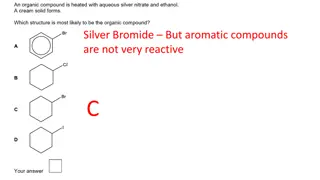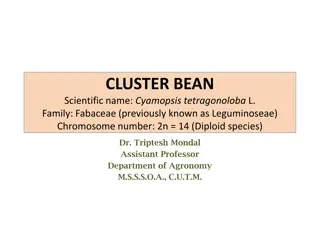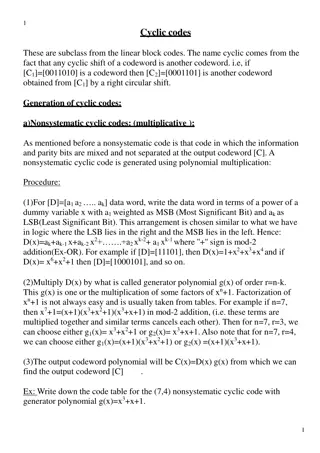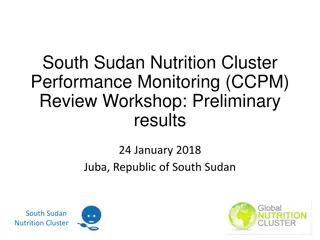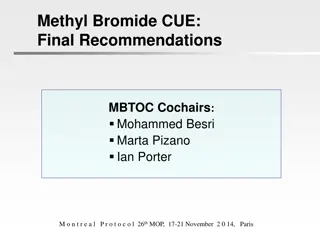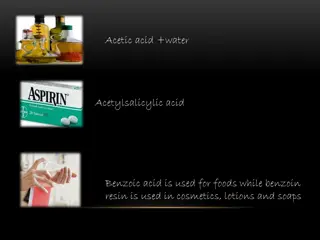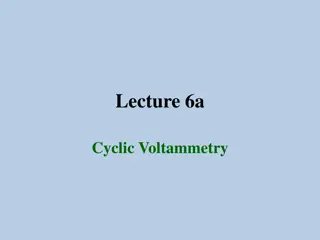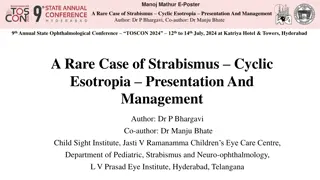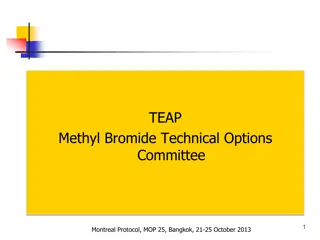Overview of Draft Risk Evaluation for Cyclic Aliphatic Bromide Cluster (HBCD)
The overview discusses the draft risk evaluation of the Cyclic Aliphatic Bromide Cluster (HBCD) conducted by Eva M. Wong, Ph.D., from the Office of Pollution Prevention and Toxics, U.S. Environmental Protection Agency. It covers sections on exposure, hazards, risk characterization, risk determination, manufacturing, import, and conditions of use assessed for HBCD. The cluster includes substances like hexabromocyclododecane and tetrabromocyclooctane, primarily used as flame retardants in polystyrene. The document details the historical production volumes, uses, and potential importation scenarios of HBCD.
Download Presentation

Please find below an Image/Link to download the presentation.
The content on the website is provided AS IS for your information and personal use only. It may not be sold, licensed, or shared on other websites without obtaining consent from the author.If you encounter any issues during the download, it is possible that the publisher has removed the file from their server.
You are allowed to download the files provided on this website for personal or commercial use, subject to the condition that they are used lawfully. All files are the property of their respective owners.
The content on the website is provided AS IS for your information and personal use only. It may not be sold, licensed, or shared on other websites without obtaining consent from the author.
E N D
Presentation Transcript
Overview of Draft Risk Evaluation Cyclic Aliphatic Bromide Cluster (HBCD) Eva M. Wong, Ph.D. Office of Pollution Prevention and Toxics U.S. Environmental Protection Agency July 10, 2019
Outline of Draft Risk Evaluation for HBCD Section 1. Introduction Chemistry and physical-chemical properties Characterization of uses/sources Systematic review summary Section 2. Exposures Environmental fate and transport assessment Environmental release assessment Occupational exposure assessment Environmental, general population, and consumer exposure assessment Section 3. Hazards Environmental hazard assessment Human health hazard assessment Section 4. Risk Characterization Findings and uncertainties Section 5. Risk Determination Unreasonable/no unreasonable risk determination 2
HBCD The cyclic aliphatic bromide cluster includes: o HBCD (Chemical Abstracts Service Registry Number [CASRN] 25637-99-4) o 1,2,5,6,9,10-hexabromocyclododecane (1,2,5,6,9,10-HBCD; CASRN 3194-55-6 o 1,2,5,6-tetrabromocyclooctane (CASRN 3194-57-8) CASRNs 25637-99-4 and 3194-55-6 are primarily used as flame retardants in polystyrene o EPA has also identified other uses including as a component of solder and use in automobile replacement parts o No uses have been identified for the CASRN 3194-57-8 3
Manufacturing and Import 1 to 10 million pounds (2016 CDR). Historically high production volume, 10-50 million lbs from 2007-2011 but fell to 1-10 million lbs/year from 2012-2015 Manufacturers and importers (2016 CDR) ceased and depleted stockpiles in 2017 (EPA communications with industry). Importation of HBCD in quantities under 100,000 lbs is possible (CDR threshold for small business reporting) 3rd party import data (Datamyne) indicates 46K lbs imported in 2017 and no importation in 2018 EPA believes that domestic manufacturing is not ongoing based on communications with industry and economic factors. However, importation in small quantities may potentially occur. 4
Conditions of Use Assessed Condition of Use Subcategory Ongoing Use Import Processing: Repackaging of Import Containers Processing: Compounding of Polystyrene Resin to Produce XPS Masterbatch XPS and EPS construction insulation (potential use) Flame retardants used in custom compounding of resin (e.g., compounding in XPS masterbatch) and in solder paste Solder paste for electronics Processing: Formulation of Flux/Solder Pastes Processing: Manufacturing of XPS Foam using XPS Masterbatch XPS and EPS construction insulation (potential use) Flame retardants used in plastics product manufacturing (manufacture of XPS and EPS foam; manufacture of structural insulated panels (SIPS) and automobile replacement parts from XPS and EPS foam) Processing: Manufacturing of XPS Foam using HBCD Powder Processing: Manufacturing of EPS Foam from Imported EPS Resin Beads Automotive replacement parts Processing: Manufacturing of SIPs and Automobile Replacement Parts from XPS/EPS Foam Recycling of XPS and EPS foam, resin, panels containing HBCD XPS and EPS (potential) Recycling of EPS Foam and Reuse of XPS Foam Activities related to distribution (e.g., loading, unloading) are considered throughout the life cycle, rather than using a single distribution scenario. Distribution Plastic articles (hard): construction and building materials covering large surface areas (e.g., EPS/XPS foam insulation in residential, public and commercial buildings, and other structures) and solder paste XPS and EPS construction insulation (potential) Use: Installation of XPS/EPS Foam Insulation in Residential, Public, and Commercial Buildings, and Other Structures Solder paste for electronics Automotive (replacement parts Use of Flux/Solder Pastes Automobile replacement parts Use: Installation of Automobile Replacement Parts Demolition and Disposal of XPS/EPS Foam Insulation Products in Residential, Public and Commercial Buildings, and Other Structures Other land disposal (e.g. Construction and Demolition Waste) 5
Receptors/Populations Human Health (includes PESS) Ecological General Population (includes children and females of reproductive age) Consumers (includes children and females of reproductive age) Aquatic Terrestrial Workers Gen Pop (Back- ground) Adult Surface Water Highly Exposed Sediment Soil Consumers (includes females of reproductive age) -Vertebrates -Invertebrates -Plants - Air - Diet (Fish) Terrestrial Species - Inhalation - Dermal - Dust/Air - Mouthing Background
Environmental Fate Environmental Fate Endpoints Serve as Inputs to o General population exposure via fish ingestion o Ecological exposure assessment o Persistence and bioaccumulation characterization Key Environmental Fate Endpoints Evaluated o Aerobic and anaerobic biodegradation o Bioaccumulation o Environmental partitioning 7
Environmental Release and Occupational Exposure Approach Environmental Releases o TRI (2017) reported data o Using CDR reporting threshold, 100,000 lbs/yr, as an import volume of HBCD modeled Emission factors and release days from the EU s risk assessment (2008) on HBCD and Australian NICNAS risk assessment (2012) on HBCD Emission factors and release days from OECD Emission Scenario Documents, EPA s Generic Scenario Documents and EU Technical Guidance Document Modeled a range of emission factors and release days Occupational Exposure o EU reported inhalation monitoring data for HBCD In the absence of applicable monitoring data, use of EPA s Total Particulates Not Otherwise Regulated (PNOR) PEL-Limiting Model o EPA/OPPT Dermal Models for contact with solids 8
Environmental, General Population and Consumer Exposure Approach Aquatic and terrestrial media and organisms o Surface water, soil, and sediment Modeling via E-FAST and VVWM-PSC using a tiered approach Environmental monitoring data, background concentrations o Aquatic and terrestrial organisms Modeling via KABAM for COU related exposures Biomonitoring data for legacy/background exposures General Population (Background) o Aggregate exposure from monitoring data for diet, dust, soil, air General Population (Highly Exposed) o Dietary and air Modeling via IIOAC (air), VVWM-PSC (dietary fish ingestion), and monitoring data o Consumer Modeling via IECCU (dust/air), monitoring data, and product data related to articles E-FAST: Exposure and Fate Assessment Screening Tool; VVWM-PSC: Variable Volume Water Model Point Source Calculator; KABAM: Kow (based) Aquatic BioAccumulation Model; COU: Condition of Use; IIOAC: Integrated Indoor-Outdoor Air Calculator; IECCU: Indoor Environmental Concentrations in Buildings with Conditioned and Unconditioned Zones; 9
Ecological and Human Health Hazard Ecological hazard o Persistence and bioaccumulation based on fate parameters o Acute and chronic toxicity for both aquatic and terrestrial organisms o Trophic transfer assessed using biomonitoring and modeling data Human health hazard o Examined dose-response for effects to thyroid hormones, liver, female reproductive, and developmental domains o Acute: developmental endpoints (neonatal mortality and reduced body weight) o Chronic: all endpoints 10
Ecological Risk The environmental risk estimates account for fate properties, potential for release, the availability of monitoring and hazard data, and modeled hazard and trophic transfer of HBCD. o Acute and chronic effect concentrations were compared to both measured and modeled environmental concentrations of HBCD in various media. Risk estimates (i.e., RQs) were calculated using both measured and modeled environmental concentrations. o Measured surface water and sediment: RQs 1 near facilities o Modeled surface water and sediment: RQs 1 for Processing: Manufacturing of EPS Foam from Imported EPS Resin beads 11
Human Health Risk Risks were estimated for workers via dermal and inhalation exposure o Inhaled HBCD was assumed to be fully absorbed through the lungs or GI o An upper-bound dermal absorption value of 6.5% was used for dermal risk estimates General population risk incorporated aggregate dust, soil, air, dietary exposures from monitoring data o Risk estimates for highly exposed receptors based on COU- specific modeled release estimates in place of the relevant monitored exposure pathway (e.g., fish ingestion, outdoor air inhalation) o Risk estimates were presented for both high and representative moderate exposure sub-scenarios 12
Conclusions Receptor Summary Determination Risk estimates for pelagic and benthic organisms were below the threshold of one for several COUs using the 50th percentile surface water concentrations The exception is the high-end sub-scenario for Manufacturing of EPS Foam from Imported EPS Resin beads Risk estimates for terrestrial organisms were above the threshold of one for one out of two COUs evaluated using the model KABAM (Manufacturing of EPS Foam from Imported EPS Resin beads) Risk estimates for soil organisms are less than the threshold of one using environmental monitoring data With consideration of all assumptions and uncertainties, EPA has determined that HBCD does not present unreasonable risks to the environment. Ecological Risk estimates for workers are below the benchmark MOE for several COUs o PPE (impervious gloves and respirator with APF 50 is expected to mitigate any potential risk) Risk estimates for the general population (background and highly exposed) are above the benchmark MOE for almost all COUs and exposure scenarios o The exception is the high-end sub-scenario for Manufacturing of EPS Foam from Imported EPS Resin Beads Risk estimates were well above benchmark for consumer articles With consideration of all assumptions and uncertainties, EPA has determined that HBCD does not present unreasonable risks for human health. Human 13








